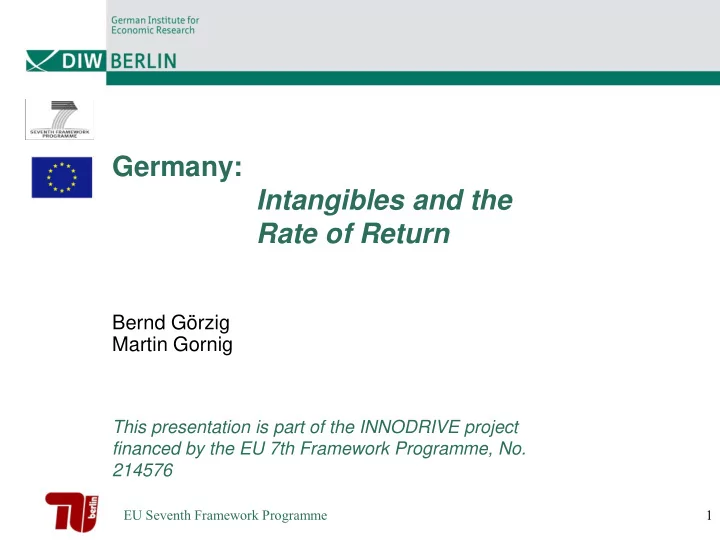

Germany: Intangibles and the Rate of Return Bernd Görzig Martin Gornig This presentation is part of the INNODRIVE project financed by the EU 7th Framework Programme, No. 214576 EU Seventh Framework Programme 1
Rate of Return on Capital Density distribution - All firms Eukleed Average net capital Rate of Return 2003 stock = (opening + closing stock)/2 valued Operating surplus 6 at historical prices minus labour compensation of self- employed 4 2 0 -.1 0 .1 .2 .3 .4 EURO per unit of capital EU Seventh Framework Programme 2
Diverging return rates: Lack of competition? Given the economists’ ideal world, return rates should not differ. Denis Mueller (1977) concluded “In an efficient market economy, profits above or below the norm should quickly disappear.” Debate in the seventies: – Is there a need for policy makers to enforce competition? EU Seventh Framework Programme 3
Diverging return rates: Measurement Error? The accounting rate of return does not measure correctly the “genuine” rate of return: Weiss (1969), Bloch (1974) Not all expenses in balance sheets, which are in the nature of capital formation are capitalized as they should under economic aspects ( Ayanian 1975), namely: – Advertising, and – R&D EU Seventh Framework Programme 4
Accountants’ and Economists’ View of Investment Accountants (national and firm level) • Classified types of (mostly) tangible goods Economists • All expenditures made in expectation of future returns Gap between both views Unobserved (mostly intangible) capital formation EU Seventh Framework Programme 5
Accounting for Unobserved Assets The case of own account production Observed production = O Hidden own account production = H Value added Y Y Y O H Investment I I I with I Y O H H H Capital stock K K K O H Depreciation D D D O H W Wages W O Asymmetric treatment of costs and value EU Seventh Framework Programme 6 added
Impact of Hidden Capital on Return Rates Operating surplus measured as residual True Positive, as long minus True profit as hidden net observed investment is profit positive Return rates “True” rate: Observed rate Competitive or ? Internal Rate Given an unique internal rate of return: Jorgensen/Griliches approach (1967) Growth rate of EU Seventh Framework Programme 7 hidden capital
Presumptions to Verify Empirically The observed rate of return could potentially be biased upward ( Ayanian 1975 ) In most empirical cases the observed rate of return overstates the “true” rate EU Seventh Framework Programme 8
The Eukleed Data Base LEED data for Germany adapted to the EU KLEMS data base Nace industries D to J, K(excl.70), N, O Employment – 77% of employment in selected industries = 23 mill. employed persons – 61% of total employment in the German economy Number of firms in 2003: 1.455 thousand – 162.000 Big Firms – with a turnover of more than 2 mill. Euro – 1.293.000 Small Firms 11% of all firms 66% of employment EU Seventh Framework Programme 9 74% of value added
Eukleed Rates of Return – 2003 – Big firms¹ (turnover All firms¹ above 2 million €) Number of firms 1.454.417 161.515 weighted 0,11 0,11 Averages³ not weighted 1,39 0,21 Standard deviation 9,08 0,40 Coefficient of variance 6,51 1,94 0,1 0,04 0,02 Percentiles 0,5 0,19 0,11 0,9 2,58 0,43 Eukleed ¹ Establishment values for Nace rev1 industries: D to J, K (excl. Rate of Return 2003 70), N, O. ² Firm-level estimates with Eukleed (2010). ³ 6 Operating surplus divided by net capital stock at historical prices. - Sources : EU KLEMS (2006), Eukleed (2010). 4 2 EU Seventh Framework Programme 10 0 -.1 0 .1 .2 .3 .4 EURO per unit of capital
Return Rates including Intangibles – All Firms 2003 – All firms¹ National accounts/ Innodrive² EU KLEMS Number of firms 1.454.417 weighted 0,11 0,10 Averages³ not weighted 1,39 0,23 Standard deviation 9,08 0,47 Coefficient of variance 6,51 2,05 0,1 0,04 0,01 Percentiles 0,5 0,19 0,10 0,9 2,58 0,65 ¹ Establishment values for Nace rev1 industries: D to J, K (excl. 70), N, O. ² Firm-level estimates with Eukleed (2010). ³ Operating surplus divided by net capital stock at historical prices. - Sources : EU KLEMS (2006), Eukleed (2010). EU Seventh Framework Programme 11
Return Rates including Intangibles – Big Firms 2003 – Big firms¹ (turnover above 2 million €) National accounts/ Innodrive² EU KLEMS Number of firms 161.515 weighted 0,11 0,09 Averages³ not weighted 0,21 0,17 Standard deviation 0,40 0,26 Coefficient of variance 1,94 1,57 0,1 0,02 0,01 Percentiles 0,5 0,11 0,09 0,9 0,43 0,37 ¹ Establishment values for Nace rev1 industries: D to J, K (excl. 70), N, O. ² Firm-level estimates with Eukleed (2010). ³ Operating surplus divided by net capital stock at historical prices. - Sources : EU KLEMS (2006), Eukleed (2010). EU Seventh Framework Programme 12
Results Theoretical and empirical evidence prove that capitalizing intangibles – Will lead to a lower level of firm-level return rates, and – The dispersion of the resulting return rates between firms diminishes EU Seventh Framework Programme 13
Conclusions Research: – Past studies on the relationship between innovation and success of firms have to be revised in the sense that intangible capital has to be included explicitly Policy: – Measured high rates of return on capital do not necessarily imply market failures but may solely indicate unsufficient coverage of capital EU Seventh Framework Programme 14
Germany: Intangibles and the Rate of Return Thank you for listening Funded by the EC under the Socioeconomic Sciences and Humanities Theme EU Seventh Framework Programme 15
Recommend
More recommend